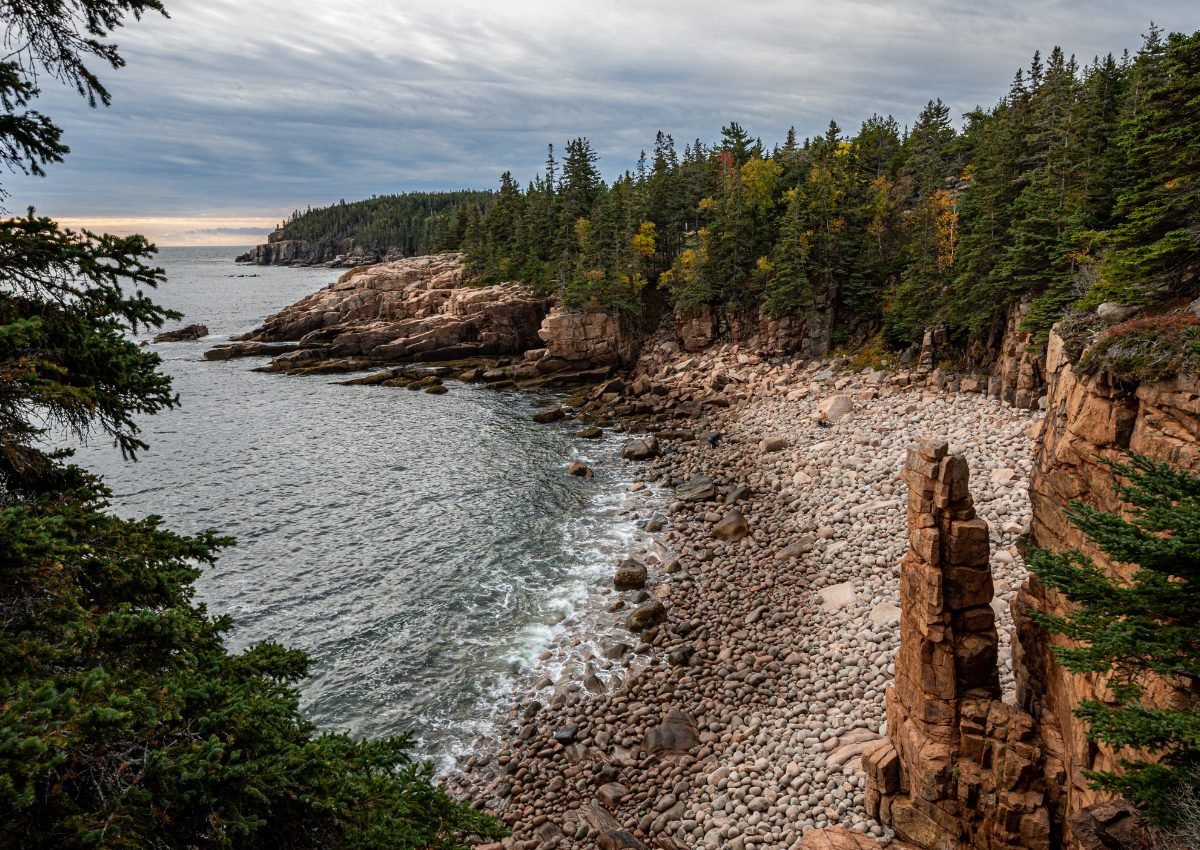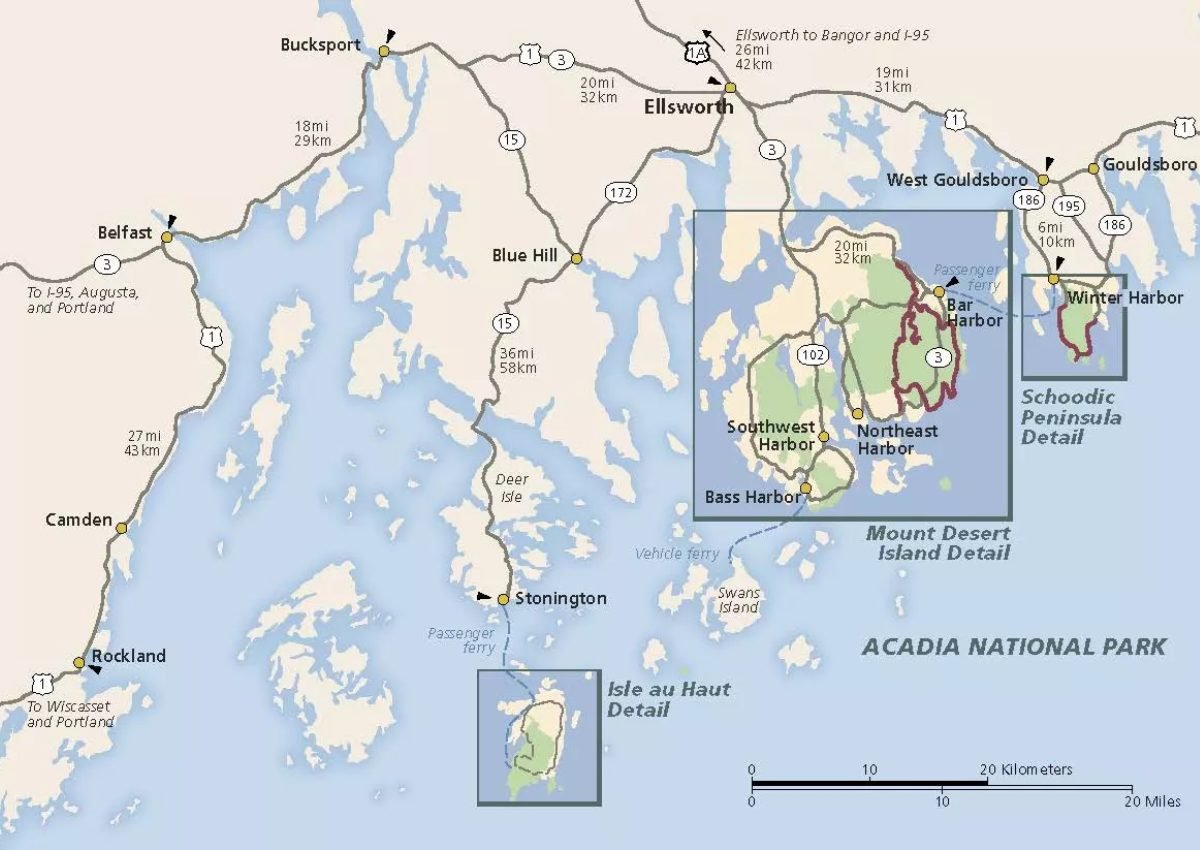Ah, the great outdoors! And by ‘great,’ we mean the jaw-dropping, heart-stopping beauty of Acadia National Park. Ready for the scoop on this natural marvel? Dive into our no-nonsense guide, “Visiting Acadia National Park – Here is Everything You Need To Know.” We’re skipping the fluff and packing all the juicy details you’ll need for this grand adventure.
So, come along on this quirky journey through time, space, and the untamed wilderness of one of America’s finest getaways. Who knows, you might find yourself or, at the very least, find the best spot to snag a killer selfie. Adventure’s calling – trust us, you’ll want to put this call on speaker!
General Information about Acadia National Park
| Aspect | Details |
| When to Go | June – early September for ideal weather, avoid July and August for fewer crowds |
| Time to Spend | 3-4 days recommended to explore the key areas |
| Getting There | Nearest airport: Bangor International Airport, then a scenic drive |
| Must-Pack | Comfortable hiking shoes, layers of clothing, binoculars for birdwatching, water-repellent jacket |
| Transportation | Car rental for flexibility, free Island Explorer shuttle bus within the park |
| Lodging | Options from campgrounds to luxurious historic hotels available |
| Wildlife Precautions | Secure food, maintain distance from animals, beware of deer ticks |
| Permits and Reservations | Required for some campgrounds and activities, book well in advance |
| Accessibility | Many trails and facilities are ADA compliant |
| Emergency Services | Dial 911 or park services for emergencies, limited cell reception in some areas |
Some exciting facts about Acadia National Park
Here are some interesting facts about Acadia National Park that you may not know:
- Acadia was the first national park east of the Mississippi River and the only one in New England.
- Acadia was initially named Lafayette National Park in honour of the French general who fought in the American Revolution.
- Acadia is home to more than 1,500 species of plants and animals, some rare or endangered.
- Acadia has the longest stretch of fjord-like coastline in the continental U.S., where deep glacial valleys meet the sea.
- Acadia hosts the oldest annual marathon in the U.S., which started in 1918 and follows a scenic route around Mount Desert Island.
Acadia National Park address
The official address for Acadia National Park is:
Address: 20 Mcfarland Hill Dr Bar Harbor, ME 04609 (207) 288-3338, Official web address: nps.gov/acad
However, this address is for the park headquarters only. The park has several entrances and visitor centers on different parts of Mount Desert Island and the Schoodic Peninsula. You can find more information about them on the park website or map.
Park History

When was Acadia National Park established?
Acadia National Park has a bit of a unique history, officially gaining national park status on February 26, 1919. But here’s a quirky fact: it wasn’t always called Acadia. Established originally as Sieur de Monts National Monument in 1916, it became Lafayette National Park in 1919, only to be renamed Acadia in 1929.
Talk about an identity crisis, right? The park’s establishment preserved the stunning natural beauty of the highest rocky headlands along the Atlantic coastline, a haven for nature lovers and escaped artists alike!
Operating Hours
Acadia National Park is open 24 hours a day, 365 days a year. However, some facilities and services have seasonal or limited hours of operation.
For example, the Park Loop Road, which provides access to most of the park’s attractions, is closed from December 1 to April 14, except for a two-mile section that remains open all year. The campgrounds are open from May to October, and some require reservations in advance.
The visitor centers have different schedules depending on the season and location. You can check the current status of park facilities and services on the park website or by calling the park headquarters.
Are the operating hours seasonal?
Absolutely, they are! The operating hours of Acadia National Park are seasonal. As mentioned above, some facilities and services are closed or have reduced hours during the winter months. This is due to weather conditions, maintenance needs, and visitor demand.
However, this does not mean the park is closed or inaccessible during the off-season. You can still enjoy many activities and experiences in Acadia throughout the year, such as hiking, snowshoeing, cross-country skiing, ice fishing, wildlife watching, or stargazing. You just need to plan ahead and be prepared for any challenges or changes.
Entrance Fees
Acadia’s entrance fees are like a “choose your own adventure” book. The rates vary based on the season, your mode of transportation, and whether you’re feeling young, old, or timeless.
It’s peak season from May 1 to October 31, so prices are a bit steeper. Here’s the breakdown:
- Individuals (on foot, bicycle, or motorcycle): $15 – $30
- Vehicles: $30 – $55 (covers all passengers)
- Seniors (62+): Discounted rates available
- Children (under 16): Free
- Persons with Disabilities: Access passes available
- Annual Pass: $55
Please note that a separate vehicle reservation is required to drive the Cadillac Summit Road from mid-May to October. You can book your reservation online in advance. Vehicle reservations are optional for other park areas or visitors who enter by foot, bike, or taxi.
Visitor Center
Acadia National Park has several visitor centers and contact stations to get information, maps, brochures, entrance passes, park store items, and ranger programs. The Hulls Cove Visitor Center is the main visitor center off Route 3 in Bar Harbor.
It is open from late April to early November, from 8:30 am to 4:30 pm2. Other visitor centers and contact stations are:
- Sieur de Monts Nature Center: Located near the Sieur de Monts Spring area on Route 3. It is open from late May to early October, from 9 am to 5 pm. It features exhibits and activities about the park’s natural and cultural history.
- Rockefeller Hall: Located at Schoodic Education and Research Center on Schoodic Peninsula. It is open from late May to early October, from 9 am to 5 pm. It features exhibits and information about local naval history and park research.
- Islesford Museum: Located on Little Cranberry Island. It is only accessible by boat. It is open from late June to early September, from 11 am to 4 pm. It features exhibits and artifacts about the island’s history and culture.
- Bar Harbor Chamber of Commerce: Located at 2 Cottage Street in downtown Bar Harbor. It is open from December to April, from 8 am to 4 pm on weekdays. It provides information and entrance passes for the park during the winter months.
What services and resources are available at the visitor center?
These centers are goldmines of information and resources. Here’s what you can find:
- Information desks where you can talk to park staff and rangers about your questions and needs.
- You can pick up Park maps and guides for free or purchase for a small fee.
- You can buy entrance passes or show your proof of purchase or federal lands pass.
- Park store where you can buy books, souvenirs, gifts, and other items related to the park.
- Ranger programs where you can join guided walks, talks, hikes, boat tours, or night sky programs that cover different topics about the park.
- Junior ranger program where you can get a booklet and complete activities to earn a badge and certificate as a junior ranger of Acadia.
- Restrooms where you can use the facilities and refill your water bottles.
- Island Explorer shuttle bus stops where you can board or exit the free bus service from late June to mid-October in the park and nearby towns.
Note: Services may vary slightly depending on which center you’re hobnobbing at.
Acadia National Park Camping & Lodging

What are the camping & lodging facilities and rules within the park?
Camping & Lodging Facilities
Each campground in Acadia is a unique gateway to exploring the wild, combining comfort with the thrill of the great outdoors.
Blackwoods Campground: located on Mount Desert Island’s scenic east side. It’s a favourite, with over 300 sites, essential amenities, and the bonus of electric hookups. Just remember to reserve your spot between May and October!
Seawall Campground: Prefer being by the sea? it is your match. It offers over 200 sites with the same basic comforts as Blackwoods but trades electric hookups for awe-inspiring coastal views. It’s open from late May to early October, with summer reservations being a must.
Schoodic Woods Campground: on the stunning Schoodic Peninsula. It’s not just the tranquillity and raw beauty that attract campers but also the practical perks like water and electric hookups among its 94 sites. Like Seawall, you must book your nature nook from late May to early September.
Duck Harbor Campground: Awaits on the remote Isle au Haut, offering a genuinely off-grid experience with just five shelters, basic facilities, and nature in full glory. Plan ahead, as this hidden gem requires booking at least two weeks in advance.
The rules for camping in Acadia National Park are:
- Ensure you have both a park entrance pass and a pre-booked campground reservation.
- Check-in at the campground office is mandatory before camp setup.
- Stick to designated camping sites, adhering to occupancy rules.
- Maintain a neat campsite, utilizing appropriate trash containers.
- Store food and wildlife attractants securely, preferably in vehicles.
- Avoid leaving the campsite unattended for over 24 hours; don’t abandon equipment.
- Respect quiet hours: 10 pm to 6 am for everyone’s peace.
- Leave the park’s natural and cultural resources undisturbed.
- Refrain from bringing in external firewood to prevent invasive species; purchase locally.
- Only use provided fire rings or grills for fires, ensuring they’re fully extinguished when unattended.
Note: If camping is not your tea, you can find various lodging options near Acadia National Park.
Are pet-friendly accommodations available?
Acadia National Park welcomes your furry companions at several campgrounds, ensuring no family member feels left out.
However, standard pet etiquette applies: keep them leashed and under control, clean up after them, and respect designated pet-friendly areas. Some lodgings outside the park also offer pet-friendly accommodations, but confirming before booking is wise.
How far in advance can you book Acadia National Park?
Booking your Acadia National Park visit requires planning, especially during peak seasons. Here’s a quick guide:
- For camping, reserve your spot on Recreation.gov at least two months ahead. These coveted sites fill up rapidly, so the earlier, the better.
- Looking for nearby hotels or rentals? It’s wise to secure your stay three to six months in advance, particularly from July to August, when availability shrinks and prices surge.
- Planning to drive up Cadillac Summit Road between mid-May and October? Make your vehicle reservation on Recreation.gov. They release 30% of slots 90 days ahead and the remaining 70% just two days in advance, attracting a rush of bookings.
Early reservations are your best bet for a hassle-free Acadia experience.
How do I make a reservation at Acadia National Park?
Is online booking available for accommodations or activities?
To make a reservation at Acadia National Park, use the official website Recreation.gov. You can book your campsite within the park, your vehicle reservation for the Cadillac Summit Road, and your ranger-led programs or tours.
You will need to create an account on the website before you can make any reservation. You must also pay the applicable fees online using a credit card or PayPal.
To book your campsite within the park, you need to follow these steps:
- Go to Recreation.gov and search for Acadia National Park Campgrounds.
- Choose the campground you prefer: Blackwoods Campground, Seawall Campground, Schoodic Woods Campground, or Duck Harbor Campground.
- Select the dates you want to camp and the number of people in your party.
- Browse the available sites and choose the one that suits your needs. You can filter by site type, amenities, accessibility, and more.
- Review the site details and rules and click on Book These Dates.
- Enter your personal and payment information and confirm your reservation.
To book your vehicle reservation for the Cadillac Summit Road, you need to follow these steps:
- Go to Recreation.gov and search for Acadia National Park Vehicle Reservations.
- Choose the date and time slot you want to drive to the summit of Cadillac Mountain.
- Review the vehicle reservation details and rules and click on Book Now.
- Enter your personal and payment information and confirm your reservation.
To book your ranger-led program or tour, you need to follow these steps:
- Go to Recreation.gov and search for Acadia National Park Ranger Programs.
- Choose the program or tour that you are interested in from the list.
- You can filter by date, time, location, topic, difficulty, etc.
- Review the program or tour details and rules and click on Book Now.
- Enter your personal and payment information and confirm your reservation.
What town to stay in when visiting Acadia National Park?
Bar Harbor takes the crown as the go-to town when visiting Acadia National Park. Nestled just outside the park’s boundaries, this charming town offers a range of accommodations, from quaint B&Bs to luxurious hotels. It’s not just about a place to crash; Bar Harbor immerses you in local culture, cuisine, and history.
Its proximity to the park’s main entrance is unbeatable for those eager to maximize their day within Acadia. For a quieter vibe, consider Southwest Harbor or Northeast Harbor, picturesque retreats just a short drive from the park.
Exploring Acadia:
Acadia national park map

Acadia National Park is a stunning destination for nature lovers, hikers, bikers, and adventurers. It covers most of Mount Desert Island and some smaller islands off the coast of Maine. The park has over 150 miles of trails, 45 miles of carriage roads, 27 miles of historic motor roads, and a variety of natural and cultural attractions.
Where can I obtain an interactive or digital map of Acadia National Park?
If you want to explore Acadia National Park on your smartphone or tablet, you can download the official Acadia National Park App from the App Store or Google Play. The app has interactive maps, GPS navigation, audio tours, photos, videos, and more. You can also access the park’s website for online maps and brochures.
Alternatively, you can use Google or Bing Maps to get directions and view satellite imagery of the park. Type “Acadia National Park” in the search box and zoom in or out to see the details.
Can you just drive through Acadia National Park?
Yes, you can just drive through Acadia National Park and enjoy the scenic views from your car. As per the entrance fee mentioned above.
The park has two main roads that loop around the island: the Park Loop Road and the Schoodic Loop Road. The Park Loop Road is 27 miles long and passes by some of the most popular attractions in the park, such as Sand Beach, Thunder Hole, Otter Cliff, Jordan Pond, and Cadillac Mountain. The Schoodic Loop Road is 8.3 miles long and runs through the Schoodic Peninsula, less crowded and more rugged than the main island.
What is the most scenic drive in Acadia National Park?
The most scenic drive in Acadia National Park is arguably the Cadillac Mountain Summit Road, which leads to the highest point in the park and on the eastern seaboard. The road is 3.5 miles long and climbs 1,530 feet above sea level.
It offers spectacular views of the ocean, islands, forests, lakes, and mountains. The road is open from mid-April to mid-November, weather permitting.
The best time to drive up Cadillac Mountain is early morning or late afternoon when the sun is low and casts a golden glow on the landscape. Depending on the season, you can also catch a stunning sunrise or sunset from the summit. Be prepared for strong winds and chilly temperatures at the top.
What is the best way to see Acadia National Park?
Exploring by car, bicycle, or on foot allows immersive experiences. However, driving through, primarily via the Park Loop Road, provides a comprehensive tour with minimal effort.
Are guided tours available?
Yes, there are guided tours available in Acadia National Park for those who want to learn more about the park’s history, ecology, geology, and culture. You can choose from ranger-led programs, bus tours, boat tours, carriage rides, bike tours, kayak tours, and more. You can find more tour information on the park’s website or at the visitor centers.
How long do I need at Acadia National Park?
The answer to this question depends on how much you want to see and do in Acadia National Park. Some people may be satisfied with a day trip or a weekend getaway, while others may want to spend a week or more exploring every corner of the park.
A good rule of thumb is to allocate at least one full day for each section of the park: Mount Desert Island (including Park Loop Road and Cadillac Mountain), Schoodic Peninsula (including Schoodic Loop Road), and Isle au Haut (accessible by ferry). This way, you can taste each area’s unique features and attractions.
Of course, you can always extend your stay or return for another visit if you love Acadia National Park.
Can you see the northern lights at Acadia?
Yes, you can see the northern lights at Acadia National Park if you are lucky enough to catch them on a clear night when there is high solar activity. The northern lights are also known as aurora borealis and are caused by charged particles from the sun interacting with Earth’s magnetic field.
What is the best time of year for this phenomenon?
The best time of year to see the northern lights at Acadia National Park is from September to March when the nights are longer and darker. However, there is no guarantee that you will see them, as they are unpredictable and depend on many factors. You can check the aurora forecast on websites like Space Weather or Aurora Service to increase your chances.
The best places to see the northern lights at Acadia National Park are away from light pollution and with a clear view of the northern horizon. Some recommended spots are Schoodic Point, Seawall, and Cadillac Mountain.
Mt. Desert Island
Mt. Desert Island is the largest island in Maine and the main hub of Acadia National Park. It is home to charming towns, historic landmarks, diverse ecosystems, and stunning scenery.
What attractions are recommended on Mt. Desert Island?
Some of the attractions that are recommended on Mt. Desert Island are:
- Sand Beach: A beautiful crescent-shaped beach with fine sand and cold water. It is one of the few sandy beaches in Maine and a popular spot for swimming, sunbathing, and picnicking.
- Thunder Hole: A natural rock formation that creates a loud boom when waves crash into it. It is best seen at high tide or during storms when the water sprays up to 40 feet high.
- Otter Cliff: A dramatic 110-foot high cliff that overlooks the Atlantic Ocean. It is a favorite spot for rock climbers and photographers.
- Jordan Pond: A serene glacial lake that reflects the twin peaks of the Bubbles. It is surrounded by a 3.5-mile trail that offers scenic views of the water and the mountains. It is also famous for its tea house that serves popovers and jam.
- Cadillac Mountain: The highest point in Acadia National Park and on the eastern seaboard. It offers panoramic views of the park and the surrounding islands. It is also the first place in the U.S. to see the sunrise from October to March.
- Bass Harbor Head Lighthouse: A picturesque lighthouse that stands on a rocky bluff at the island’s southern tip. It was built in 1858 and is still in operation today. It is one of the most photographed lighthouses in Maine.
Bar Harbor
Bar Harbor is a quaint seaside town that serves as the gateway to Acadia National Park. It has a rich history, a vibrant culture, and a charming atmosphere.
What are some must-visit places in Bar Harbor?
Some of the must-visit places in Bar Harbor are:
- Bar Harbor Historical Society Museum: A museum that showcases the town’s past, from its origins as a fishing village to its heyday as a summer resort for the rich and famous. It has exhibits, artifacts, photos, and videos that tell the stories of Bar Harbor’s people, places, and events.
- Abbe Museum: A museum that celebrates the culture and history of the Wabanaki people, the native inhabitants of Maine and Maritime Canada. It has collections, displays, programs, and events that educate and inspire visitors about the Wabanaki’s art, traditions, and values.
- Village Green: A central park that hosts concerts, festivals, markets, and other activities throughout the year. It is also a great place to relax, enjoy the flowers, and watch the people go by.
- Shore Path: A scenic walkway that follows the edge of Frenchman Bay for about a mile. It offers stunning views of the water, the islands, and the mountains. It also passes by some historic mansions and cottages belonging to Bar Harbor’s elite.
- Main Street: A lively street that has a variety of shops, restaurants, bars, galleries, and museums. It is a great place to find souvenirs, local crafts, seafood delicacies, ice cream treats, and more.
Special Features:
Why is Acadia so special?
Acadia National Park is one of the most visited parks in the U.S., and for good reasons. It has a unique combination of natural and cultural features that make it stand out from other parks. Here are some of them:

Unique ecological features, historical significance, etc.
- Acadia is the only national park in the Northeastern U.S. and the first one east of the Mississippi River.
- Acadia has a diverse landscape of mountains, forests, lakes, ponds, wetlands, and rocky coastlines. It is home to over 1,500 plant species and 300 bird species.
- Acadia has the highest mountain on the Atlantic coast of the U.S., Cadillac Mountain, which is also the first place in the U.S. to see the sunrise from October to March.
- Acadia has a rich history of Native American habitation, French exploration, British colonization, the American Revolution, the Civil War, the Gilded Age, the conservation movement, and more.
- Acadia was created by private donations of land from wealthy philanthropists and local residents who wanted to preserve the natural beauty and cultural heritage of the area.
What is the closest major city to Acadia National Park?
The closest major city to Acadia National Park is Portland, Maine. It is about 160 miles or 3 hours drive from the park. Portland is the largest city in Maine and a popular destination for its historic Old Port district, art galleries, museums, restaurants, breweries, and waterfront activities.
Other cities and towns near Acadia National Park include Bangor (50 miles), Ellsworth (15 miles), Bar Harbor (8 miles), Southwest Harbor (10 miles), and Trenton (9 miles).
Wildlife in Acadia:
Acadia National Park is a haven for wildlife lovers. The park hosts a variety of animals that live in different habitats and adapt to different seasons. Some of the wildlife you might see during your visit are:
What wildlife might I see during my visit?
- Mammals: You might encounter white-tailed deer, red foxes, coyotes, raccoons, porcupines, beavers, otters, mink, fishers, martens, bobcats, bats, mice, squirrels, chipmunks, and flying squirrels. If you are fortunate, you might even spot a moose or a black bear.
- Birds: You might see bald eagles, peregrine falcons, owls, loons, ducks, geese, herons, gulls, terns, cormorants, puffins, woodpeckers, warblers, chickadees, nuthatches, and many more. Some birds are year-round residents, while others are migratory or seasonal visitors.
- Marine wildlife: You might catch a glimpse of seals, whales, dolphins, porpoises, sharks, sunfish, tuna, cod, herring, lobster, crab, shrimp, mussels, clams, oysters, snails, starfish, sea urchins, and more. Some marine wildlife live in the intertidal zone, where they are exposed to air and water depending on the tide. Others live in deeper waters where they face threats from fishing, pollution and climate change.
Safety and Regulations:
What are the safety guidelines for Acadia National Park?
Acadia National Park is a beautiful place to enjoy nature, but it also has some hazards and risks you should be aware of. Here are some safety tips to follow during your visit:
During outdoor activities, encountering wildlife, etc.
- Stay on designated trails and avoid walking near cliff edges or slippery rocks.
- Carry enough water, snacks, clothing, and a map or GPS device. Do not rely on your phone as cell service is spotty in the park.
- Tell someone your plans and when you expect to return. If you get lost or injured, stay in one place and wait for help.
- Check for ticks after hiking and remove them promptly. Ticks can carry diseases such as Lyme disease and anaplasmosis.
- Do not feed or approach wildlife. They may be cute, but they are also wild and unpredictable. Feeding wildlife is illegal and harmful to their health.
- Keep your food and trash in a hard-sided container or vehicle. Do not leave them unattended or dispose of them improperly. They may attract animals such as raccoons, porcupines, or bears.
Are there any park regulations visitors should be aware of?
Acadia National Park is a protected area that aims to preserve natural and cultural resources for future generations. As a visitor, you must respect the park rules and regulations. Here are some of them:
Preservation of park features, trash disposal, pet rules, etc.
- Do not collect or disturb any natural or historical objects, such as rocks, plants, fossils, artifacts, or structures. They are part of the park’s heritage and ecosystem.
- Pack out what you pack in. Do not litter or dump any waste in the park. Use the designated trash cans or recycling bins.
- Keep your pets on a leash no longer than six feet at all times. Pets are not allowed on most trails, carriage roads, beaches, or public buildings. Clean up after your pet and dispose of the waste properly.
- Obey the speed limits and traffic signs on park roads. Do not pass or tailgate other vehicles. Watch out for pedestrians, bicyclists, wildlife, and blind curves.
- Follow the fire regulations and use only park-provided grills or fire rings for cooking or campfires. Do not bring firewood from outside the park as it may carry invasive pests or diseases.
In closing, a trip to Acadia National Park emerges not just as a getaway but as a transformative journey. This haven, marrying the raw beauty of mountain terrain with the serene complexity of the Atlantic seascape, is more than a sightseeing spot; it’s an experience that etches itself into your memory.
From the rugged, rocky cliffs and panoramic summit views atop Cadillac Mountain to the tranquility of walking the forest trails or kayaking along the coastline, Acadia presents each visitor with a unique communion with nature.
As we’ve explored, preparation is key to making the most of what the park offers. Understanding the best times to visit, the regulations in place, and the variety of activities available ensures a seamless, immersive experience.
Respect for the park’s ecological integrity is paramount, emphasizing the responsibility each visitor holds in preserving this national treasure for future generations.
Whether you’re drawn by the call of the wild, the thrill of exploration, or the pursuit of tranquility, Acadia National Park encompasses something special for everyone. It stands as a testament to nature’s enduring solace and grandeur, promising to rejuvenate and inspire all who tread its sacred grounds. May your visit here echo with laughter, resonate with adventure, and, above all, instill a renewed sense of wonder.






